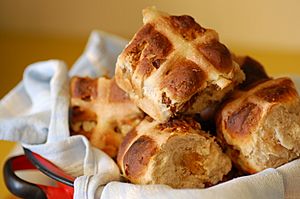Hot cross bun facts for kids

Homemade hot cross buns
|
|
| Type | Spiced bun |
|---|---|
| Place of origin | United Kingdom |
| Region or state | England |
| Main ingredients | Flour, currants or raisins with spices |
A hot cross bun is a sweet, spiced bun. It usually has fruit inside, like currants or raisins. A special cross is marked on top of the bun.
These buns are traditionally eaten on Good Friday. This day is important in many countries, including the United Kingdom, Ireland, Australia, and New Zealand. They are also popular in parts of the Americas.
The bun marks the end of Lent, a time when some people give up certain foods. The cross on the bun reminds people of the crucifixion of Jesus. The spices inside the bun can represent the spices used to prepare him for burial. Sometimes, orange peel is added, which can symbolize the bitterness of his time on the Cross.
Today, you can often find hot cross buns all year round in some places. In Australia and New Zealand, they might even appear in stores as early as New Year's Day!
Contents
The History of Hot Cross Buns
In many countries with a Christian history, people traditionally ate plain buns on Good Friday. These buns were made without dairy products. Dairy was often avoided during Lent until Palm Sunday.
Some historians believe that the idea of marking cakes with a cross started with the Greeks around the 6th century AD.
Where Did Hot Cross Buns Come From?
One popular idea is that the hot cross bun began in St Albans, England. A monk named Brother Thomas Rodcliffe lived there in the 14th century. He worked at St Albans Abbey.
In 1361, Brother Thomas created a special recipe called an 'Alban Bun'. He would give these buns to poor people in the area on Good Friday. This might be how the hot cross bun tradition started!
Old Rules About Buns
During the time of Elizabeth I of England in 1592, there were strict rules in London. The Clerk of Markets made a law that said hot cross buns and other spiced breads could not be sold. They were only allowed to be sold at funerals, on Good Friday, or at Christmas.
If someone broke this rule, their buns would be taken away and given to the poor. Because of this, most hot cross buns were made at home during that time. More attempts to stop their sale happened when James I of England was king (1603–1625).
The first clear mention of hot cross buns in writing was in 1733. It was in a London street rhyme from Poor Robin's Almanac: "Good Friday comes this month, the old woman runs. With one or two a penny hot cross buns."
Hot Cross Bun Traditions
English folklore has many interesting superstitions about hot cross buns.
- One belief says that buns baked on Good Friday will not go bad or grow mouldy for a whole year.
- Another tradition suggests keeping a bun for health reasons. If someone is sick, giving them a piece of the bun is thought to help them get better.
- If you take hot cross buns on a sea trip, they are said to protect against shipwrecks.
- Hanging a bun in the kitchen is believed to protect the house from fires. It also supposedly makes sure all other breads turn out perfectly. This hanging bun is replaced with a fresh one every year.
Different Kinds of Hot Cross Buns
Today, you can find many different versions of hot cross buns.
Variations in the United Kingdom
In the United Kingdom, big supermarkets make many kinds of hot cross buns. Some popular flavors include:
Variations in Australia
In Australia, some bakeries sell coffee-flavored buns. You can also find sticky date and caramel versions. There are even mini versions of the traditional bun! Other new flavors in stores include:
- choc chip
- chocolate and cherry
- butterscotch
- apple & cinnamon
- banana and caramel
- white chocolate and raspberry
Not Cross Buns
The Not Cross Bun is a fun twist on the traditional hot cross bun. It uses the same ingredients but has a different design piped on top instead of a cross. Sonoma Baking Company in Sydney says they made the first Not Cross Bun for sale in 2012. Their version has an 'S' piped on it.
Similar Buns in Other Countries
In Slovakia and Czechia, there is a similar sweet bread called mazanec. It is eaten at Easter and often has a cross marked on top, just like hot cross buns.
Making the Cross on the Bun
The traditional way to make the cross on top of a hot cross bun is by using shortcrust pastry. This is a type of dough. However, some modern recipes suggest using a simple paste made from flour and water to create the cross.
Images for kids
See also
 In Spanish: Panecillo de Pascua para niños
In Spanish: Panecillo de Pascua para niños



